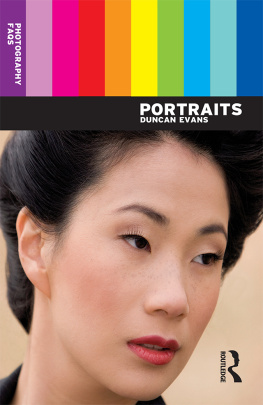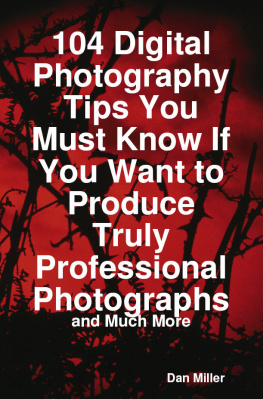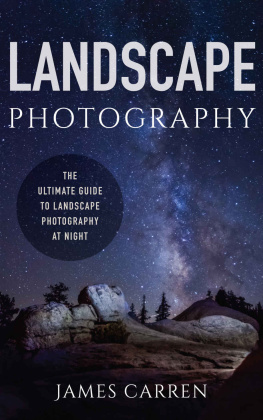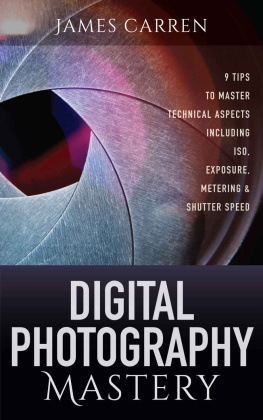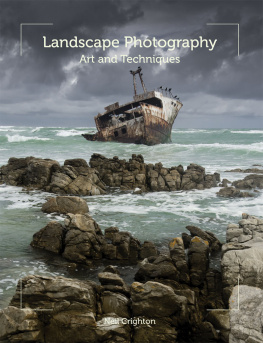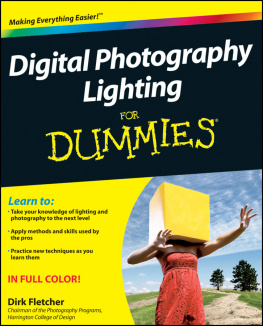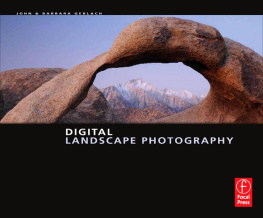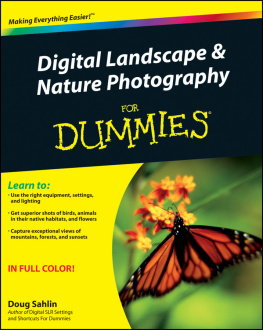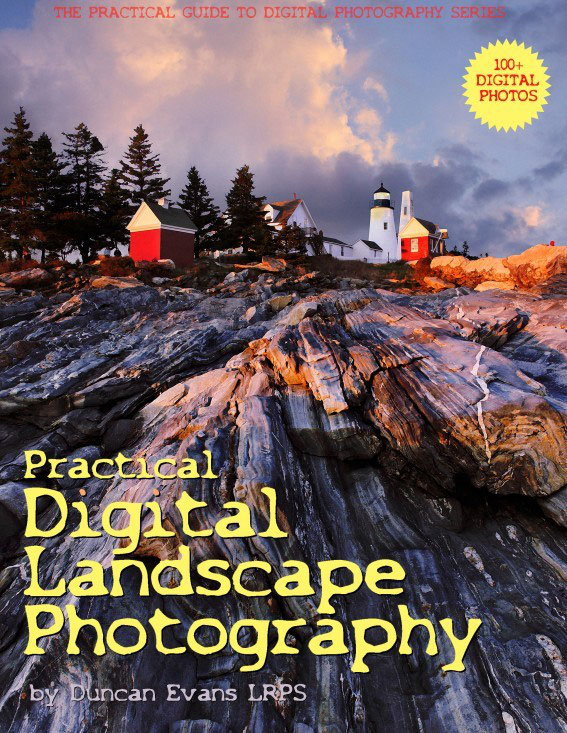Practical
Digital
Landscape
Photography
by Duncan Evans LRPS
Copyright 2016 Duncan Evans
Smashwords Edition
License Notes
This ebook is licensed for your personal enjoyment only. This ebook may not be re-sold or given away to other people. If you would like to share this book with another person, please purchase an additional copy for each recipient. If youre reading this book and did not purchase it, or it was not purchased for your use only, then please return to your favorite ebook retailer and purchase your own copy. Thank you for respecting the hard work of this author.
TABLE OF CONTENTS
INTRODUCTION
CHAPTER GETTING STARTED
CHAPTER THE GOLDEN HOUR
CHAPTER MOUNTAINS AND HILLS
CHAPTER WATERFALLS AND STREAMS
CHAPTER AFTER SUNSET
CHAPTER CASTLES AND BRIDGES
CHAPTER LIGHTHOUSES
CHAPTER IF YOU GO DOWN TO THE WOODS
CHAPTER WINDMILLS AND WATERMILLS
CHAPTER COUNTRY HOUSES
CHAPTER GOING UNDERGROUND
CHAPTER BIG CITY LIGHTS
CHAPTER BAD WEATHER BLACK AND WHITE
CHAPTER THE DIGITAL DARKROOM
GLOSSARY
APPENDIX
CONTENTS
INTRODUCTION
CHAPTER GETTING STARTED
What the book is all about and the gear you do and dont need.
CHAPTER THE GOLDEN HOUR
Whether its coming up or going down, the hour before sunset and sunrise is special.
CHAPTER MOUNTAINS AND HILLS
Capture the grandeur and spectacle of towering rock formations.
CHAPTER WATERFALLS AND STREAMS
Essential techniques for creative effects with flowing water.
CHAPTER AFTER SUNSET
When the sun has gone down there are photographic opportunities.
CHAPTER CASTLES AND BRIDGES
Features of the landscape that set their mark on it.
CHAPTER LIGHTHOUSES
How to compose photos with very tall, thin buildings.
CHAPTER IF YOU GO DOWN TO THE WOODS
Cant see the wood for the trees? Discover what there is to shoot.
CHAPTER WINDMILLS AND WATERMILLS
Industrial features and the associated landscapes around them.
CHAPTER COUNTRY HOUSES
What a big house and extensive gardens has to offer the photographer.
CHAPTER GOING UNDERGROUND
Explore the dim and dark recesses of caverns, grottos and tunnels.
CHAPTER BIG CITY LIGHTS
The urban side of the landscape, after dark, with neon lights everywhere.
CHAPTER BAD WEATHER BLACK AND WHITE
When the weather doesnt play ball, heres how to get some worthwhile shots.
CHAPTER THE DIGITAL DARKROOM
GLOSSARY
A guide to digital photography language and terms.
APPENDIX
INTRODUCTION
Landscape photography is one of the most loved genres of photography, and with good reason. There is little that can compete with a beautiful scene awash with golden light. Actually turning that scene into a digital photo to remember requires patience, a good eye, timing, technical know-how and either plenty of time or lots of luck. Yes, landscape photography is popular alright, because everyone loves getting out into the countryside with their camera, but creating great landscape photos with your digital camera is anything but easy.
Fortunately thats where this ebook comes in, with plenty of advice and help for getting started with all the common landscape arenas such as mountains, waterfalls and woods, and some that you might not immediately think of, like lighthouses, shooting underground and what to do in bad weather.
All the advice is practical of course and tells you what you need to know to get shooting those digital landscapes successfully.
Duncan Evans LRPS
www.duncanevans.co.uk
CHAPTER - GETTING STARTED
The first question to ask when talking about capturing landscapes digitally, is what kind of camera do you need? On the face of it you can take a picture with anything from a camera phone upwards. To print an A4 image at 300dpi you only an 8Mp resolution and plenty of smartphones offer that already. However resolution is only the start, to really take good landscape photos you need more than this and thats why camera phones are great for holiday snaps, but not for serious photos. The same applies to compact cameras for the same reasons and they are lens distortion, the ability to use filters and complete control over the camera aperture and shutter speed.
Lets start with lenses. The lens in a compact and camera phone is smaller and not the same quality as that on a DSLR. The ones in a compact arent bad, and compared next to each other, you might be hard pressed to tell the difference on some images. However, on others and when faced with glare and reflections it wont cope as well. The real issue though is depth-of-field and image sharpness and detail from front to back. Here the compact camera detail can turn details to mush while the DSLR brings you every grain of sand. Because of the proximity of the lens to the sensor there is much more depth-of-field at all apertures in camera phones and compact cameras. Now thats a good thing in landscape photography, but there simply isnt the same sharpness or detail that is able to be resolved throughout the image. On some images, where there is a specific object in the scene that you want to focus on, you can get away with a compact. And there are circumstances where a small camera is a positive boon or simply more practical.
However, for big landscape images the other factors of using filters and having complete control over the exposure really drive the point home. For digital landscape photography you need a DSLR, that records images of 12Mp or more, with interchangeable lenses. Now I will add here that you can also use the relatively new format, the compact camera system, which uses a compact-size body but adds DSLR-quality lenses.
When it comes to filters, there are a basic set that will stand you in good stead. For these you usually need a filter holder that screws to the front of a lens. Into it the filters can then be stacked. The best quality ones are made of glass but you can get by with plastic ones if its all you can afford. The essential filters are a polariser, neutral density and graduated neutral density. You dont need starburst, rainbow or other tacky effects filters and, thanks to digital white balance control, you dont need warm up or cool down filters. The purpose of the polariser is to reduce certain wavelengths of light. In practice that means you can darken skies, shoot through glass and the surface of water. To be effective the light source, ie the sun, needs to at degrees to the camera. The polariser is usually circular and is rotated in the lens holder until the particular effect want has been achieved.
The neutral density filters are an absolute essential in landscape photography. Firstly, the complete ND filter reduces light coming into the camera in a uniform way, without affecting the colour. The purpose of this is particular when shooting moving water. It allows you to increase the length of time the shutter is open, even during the day. The longer the exposure, the smoother the water. ND filters are rated by how many stops of light they block, and typically go in steps of two, so you have ND2, ND4 and so on. The graduated ND filter works on similar principle but in this case goes from the blocking element to clear in a graduated fashion. There are two types: the hard grad and the soft one. This simply means that the transition between filter and clear is a short one or a long one. The purpose of the graduated ND filter is usually to control bright skies. A bright sky can create too much contrast in a scene for a camera, with the result that either the ground is underexposed or all the detail in the sky is lost. By reducing the brightness of the sky you can create a more balanced exposure that the camera can manage. A final mention goes to the UV filter which usually screws onto the front of a lens. This has two purposes. One is that it reduces blue UV haze, and the second is that it protects the front of the lens from accidents.


